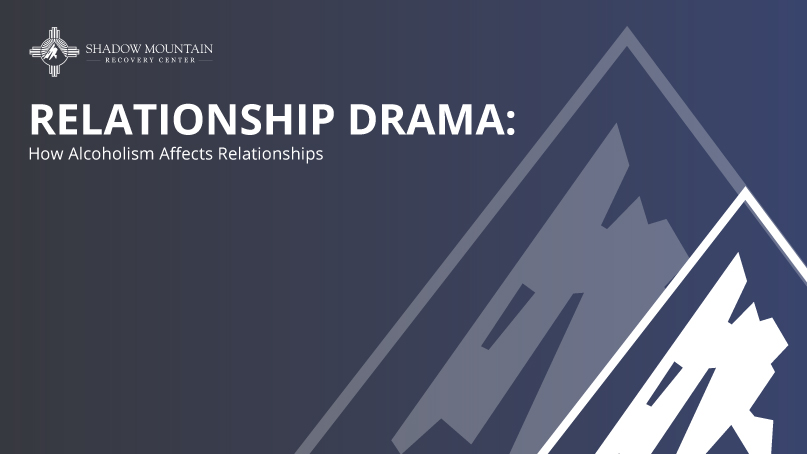Relationship Drama: How Does Alcoholism Affect Relationships
When two people engage in a relationship, there is bound to be drama eventually. That drama is an unfortunate part of life. Sometimes, it can be small issues where you don’t even remember what started the drama, and you can both look back and laugh. Other times, it can be larger issues, and one of the largest issues that a person can endure is alcohol use disorder, more commonly called alcoholism.
It is often understated what the partner of someone with an addiction endures. It hurts them to see their partner going through addiction. It hurts emotionally and mentally, but sometimes, unfortunately, it hurts physically as well. In this piece, we will discuss how alcohol use disorder affects relationships, the dangers of having a partner with an alcohol addiction, and options for treatment at Shadow Mountain Recovery.
How Does Alcoholism Affect Relationships?
Alcohol can affect a relationship in several damaging ways. First, let’s look at some of the statistics on married people and alcohol. About 25% of married couples have a husband who drinks regularly (meaning at least once per month) while the wife doesn’t, and about 12% of couples have a husband who drinks heavily (meaning 15 or more drinks per week), according to a study from the University at Buffalo Clinical and Research Institute on Addictions.
It was also reported by the university that heavy drinking, alcohol use disorder, and other alcohol-related problems are associated with lower marital satisfaction.
Comparatively, couples where neither spouse had an alcohol-related disorder experienced more positive interactions than couples where one spouse has an alcohol-related disorder. Along with this, one of the most common reasons for divorce is alcohol/substance use (third most common for women and eighth most common for men).
Alcohol Use and Intimate Partner Violence
Alcohol is unfortunately a catalyst for intimate partner violence. According to the World Health Organization (WHO), evidence suggests that alcohol use increases the occurrence of intimate partner violence. There are several pieces of evidence that support the relationship between alcohol use and intimate partner violence. These include:
- Alcohol use directly affects physical and cognitive (thinking and reasoning) abilities, which reduces self-control and leaves people much less capable of negotiating within a relationship in a non-violent manner
- Individual and societal beliefs that alcohol use causes aggression can encourage violent behavior after drinking, and beliefs that the use of alcohol excuses violent behavior
- Experiencing violence within a relationship can lead to alcohol use as a coping method
In the United States, 55% of the victims of intimate partner violence believed that their partner was drinking prior to a physical assault. While there is some violence by women toward men, it is mainly reported that there is violence by men toward women.
Support Groups for Partners in New Mexico
You are not alone. There are many others who have felt as if they can’t help their partner, and many have unfortunately experienced violence from their partner. There are several support groups that can help you if you have suffered from intimate partner violence, and/or if your partner struggles with alcohol use disorder:
- Survivor Services: There are several domestic violence victim service providers that provide immediate shelter and support for victims. Visit here to learn more about the survivor services in New Mexico.
- National Council on Alcoholism and Drug Dependence (NCADD): This support group can put you in touch with healthcare professionals and prepare you for an intervention with your spouse. Call (800) 622-2255 or visit their website to find your local chapter.
- Al-Anon family groups: At Al-Anon meetings, family members of someone with a drinking problem have the opportunity to learn from the experiences of others who have faced similar problems. Call (888) 425-2666 to find more information about your local chapter of Al-Anon or visit the Al-Anon website.
Alcohol Use Disorder (AUD)
Alcohol use disorder (AUD), more commonly called alcoholism, is an addiction to alcohol. According to the National Institute on Alcohol Abuse and Alcoholism, there are certain criteria used to determine what “type” of AUD someone is suffering from. These criteria include the questions below.
In the past year, have you:
- Found that drinking — or being sick from drinking — often interfered with taking care of your home or family? Or caused job troubles? Or school problems?
- Had times when you ended up drinking more, or longer, than you intended?
- Spent a lot of time drinking? Or being sick or getting over other after effects?
- Given up or cut back on activities that were important or interesting to you, or gave you pleasure, in order to drink?
- More than once wanted to cut down or stop drinking, or tried to, but couldn’t?
- Wanted a drink so badly you couldn’t think of anything else?
- More than once gotten into situations while or after drinking that increased your chances of getting hurt (such as driving, swimming, using machinery, walking in a dangerous area, or having unprotected sex)?
- Continued to drink even though it was making you feel depressed or anxious or adding to another health problem? Or after having had a memory blackout?
- Had to drink much more than you once did to get the effect you want? Or found that your usual number of drinks had much less effect than before?
- Found that when the effects of alcohol were wearing off, you had withdrawal symptoms, such as trouble sleeping, shakiness, restlessness, nausea, sweating, a racing heart, or a seizure? Or sensed things that were not there?
- Continued to drink even though it was causing trouble with your family or friends?
If you answered “yes” to two or three of these, then you may have mild AUD; four to five would be moderate AUD; and six or more would be severe AUD. Someone with AUD is also more likely to binge drink.
Binge Drinking
Binge drinking, the most common form of excessive drinking, is where a person drinks over the recommended average within two hours. For men, this would be drinking five or more alcoholic drinks, and for women, it would be four or more drinks.
One in six adults binge drinks about four times per month, consuming about seven drinks per binge. The majority of binge drinks are consumed by those who are age 35 and up. While binge drinking doesn’t typically mean that someone has an alcohol use disorder, it is a practice that can lead to it.
Binge drinking increases the risk of accidental injuries like falls and burns; can lead to several chronic diseases, such as high blood pressure, liver disease, and heart disease; and can lead to incidences of violence.
It can also lead to several cancers, as well as a disease called cirrhosis of the liver.
Cirrhosis of the Liver
Cirrhosis of the liver is a late-stage fibrosis (scarring) of the liver. When we drink, our liver is injured but repairs itself. Usually, after that repair, it leaves a little bit of scar tissue. This is minimal scar tissue, and the liver can still perform its job (getting toxins out of the body), but cirrhosis makes scar tissue continuously form. It forms to the point of the liver not being able to be repaired or do its job. While the signs and symptoms of cirrhosis don’t show up until the liver has significant damage, they include:
- Itchy skin
- Nausea and vomiting
- Jaundice (yellow discoloration of skin and eyes)
- Weight loss
Alcohol Use in New Mexico
New Mexico has a checkered history with alcohol use. From 1981 to 2010, the Land of Enchantment ranked either first, second, or third in alcohol-related deaths. The New Mexico Department of Health reports that in 2019, New Mexico had the highest alcohol-related death rate in the nation, and one in five deaths of adults ages 20-64 in the state was due to alcohol.
These are staggering statistics, and these are the reasons Shadow Mountain Recovery has alcohol addiction rehab.
Alcohol Abuse Treatment at Shadow Mountain Recovery
AUD affects plenty of New Mexicans. We understand this and offer treatment for alcohol addiction. Every client is different, which means we have several different treatment methods. One of the first portions of treatment will be getting rid of all the alcohol in your body. This is called detox.
Alcohol Detox
Detoxing from alcohol can be dangerous. There is a level of shock that comes from frequently drinking to not drinking at all, and that shock shows up in unpleasant withdrawal symptoms. These symptoms include:
- Depression
- Anxiety
- Mental confusion
- Mood swings
- Nightmares (bad dreams)
This is why we offer medical detox. During medical detox, we guide our clients through these symptoms and use medications to ease the symptoms, if necessary. We will address the mental and emotional tolls detox takes on clients while providing support through the hardest nights. After this, we will start the next part of the client’s treatment plan, which is therapy.
Dialectical Behavior Therapy (DBT)
Change and acceptance are two core components of a healthy recovery. Blending these two opposites together is what the term “dialectic” means and is the core of this form of therapy.
Dialectical behavior therapy (DBT) helps clients learn to accept what they can’t change and change what they can’t accept. DBT teaches four skills that are based on change and acceptance. These skills include:
- Emotional regulation: Teaching clients how to change the emotions they can’t accept while decreasing vulnerability to certain emotions
- Distress tolerance: Learning how to accept stressful situations without changing them
- Mindfulness: Staying present in the moment and accepting it for what it is
- Interpersonal effectiveness: Teaching clients how to maintain self-respect and dignity while asking for something, and being able to say “no” to others
Cognitive Behavioral Therapy (CBT)
Known as the gold standard of therapy, cognitive behavioral therapy (CBT) will aim to catch the inaccurate and harmful thinking patterns of the client. CBT aims to change two patterns: behavioral and thinking. To change behavioral patterns, cognitive behavioral therapy uses these strategies:
- Facing one’s fears instead of avoiding them
- Learning to relax one’s mind and body
- Using role-play to prepare for interactions with others
To change thinking patterns, CBT uses these strategies:
- Using problem-solving skills to cope with stressful situations
- Learning to develop self-confidence
- Gaining a better understanding of the motivations of others
- Learning to recognize warped thinking patterns and reevaluating them in light of reality
CBT is known for having homework – activities done outside the therapy session – to address the specific needs of the client. This could be reading something that applies to you or even confronting a problematic individual in your life. CBT works best when the client shares their feelings. While this can be difficult, you will get the most out of therapy by doing this.
Start Your Journey at Shadow Mountain Recovery
Shadow Mountain Recovery is here to help you or your loved one overcome addiction. Our goal is to give you alternatives to 12-step programming by offering holistic treatment options along with other evidence-based practices. Located in Albuquerque, Rio Rancho, Taos, and Santa Fe, our treatment facilities aim to teach our clients the reality that change is possible without losing yourself. Call 505-657-2117 to begin healing.









